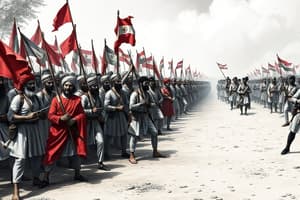Podcast
Questions and Answers
What policy did Lord Dalhousie implement to annex kingdoms without male heirs?
What policy did Lord Dalhousie implement to annex kingdoms without male heirs?
- Doctrine of Control
- Doctrine of Lapse (correct)
- Doctrine of Legacy
- Doctrine of Sovereignty
Nana Sahib was granted an annual pension by the British after the death of Peshwa Baji Rao II.
Nana Sahib was granted an annual pension by the British after the death of Peshwa Baji Rao II.
False (B)
What was one major economic impact of British policies on Indian textiles?
What was one major economic impact of British policies on Indian textiles?
The influx of cheap British goods led to unemployment in the Indian textile industry.
The last Mughal Emperor of India was ______.
The last Mughal Emperor of India was ______.
Match the following figures with their respective actions or titles:
Match the following figures with their respective actions or titles:
What policy implemented by Lord Dalhousie led to the annexation of states like Jhansi and Awadh?
What policy implemented by Lord Dalhousie led to the annexation of states like Jhansi and Awadh?
The Revolt of 1857 is known as the First War of Independence in Indian history.
The Revolt of 1857 is known as the First War of Independence in Indian history.
Name one key reason that contributed to the economic downturn in India before the Revolt of 1857.
Name one key reason that contributed to the economic downturn in India before the Revolt of 1857.
The British ill-treated Rani Lakshmibai and unjustly annexed her state, __________.
The British ill-treated Rani Lakshmibai and unjustly annexed her state, __________.
Match the following states with their annexation years under the Doctrine of Lapse:
Match the following states with their annexation years under the Doctrine of Lapse:
Flashcards are hidden until you start studying
Study Notes
Causes of the Revolt of 1857
- Annexation Policy: Lord Dalhousie's Doctrine of Lapse led to the annexation of states like Satara, Jhansi, and Awadh if rulers had no male heirs, fostering resentment among Indian rulers and subjects.
- British Injustice: Treating figures like Rani Lakshmibai unjustly and denying pensions to leaders like Nana Sahib incited opposition against British rule.
- Economic Exploitation: Introduction of machine-made British goods devastated traditional handicrafts, causing unemployment and economic hardships among local artisans.
- Over-taxation and Revenue Policies: Heavy taxation imposed by zamindars and the British crushed peasant livelihoods, leading to widespread discontent.
Socio-Religious Causes
- Interference in Customs: British legislation, such as the Sati Prohibition Act and the Widow Remarriage Act, conflicted with traditional practices, creating mistrust.
- Fear of Religious Disruption: Increased British presence through infrastructure like railways heightened fears of cultural and religious erosion.
- Religious Taxation: Taxes levied on religious institutions antagonized local sentiments and fueled rebellion.
Military Discontent
- Disparities in Pay and Promotion: Indian soldiers faced lower salaries compared to British troops and limited career advancement, fostering resentment.
- General Service Enlistment Act: Mandatory overseas service offended Indian soldiers' religious beliefs, as crossing seas was seen as polluting.
Immediate Cause
- Greased Cartridges: The use of cartridges greased with cow and pig fat triggered outrage among Hindus and Muslims, leading to Mangal Pandey's revolt on March 29, 1857.
Spread and Key Events of the Revolt
- Delhi Rebellion: On May 9, 1857, sepoys from Meerut marched to Delhi, declaring Bahadur Shah Zafar as the rebellion's leader.
- Kanpur Insurrection: Nana Sahib and Tantia Tope besieged British holdouts, but the situation escalated with brutal retaliations by British forces.
- Lucknow Siege: Begum Hazrat Mahal led the defense of the Residency, which withstood a prolonged siege by British troops until late 1857.
- Jhansi Resistance: Rani Lakshmibai's leadership and bravery inspired many, affecting the course of the revolt before her defeat.
Consequences and Historical Impact
- The revolt marked a significant challenge to British authority, leading to a reevaluation of colonial policies in India, and is viewed by Indian historians as the First War of Independence.
Studying That Suits You
Use AI to generate personalized quizzes and flashcards to suit your learning preferences.




